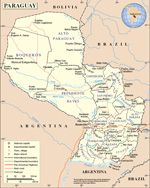The armchair tourist is told three things about Paraguay:
- be wary of ever leaving the city,
- corruption is everywhere,
- and soybeans, lots and lots of soybeans.
Coming off 50 years of shaky democracy-turned-dictatorship, Paraguay has done remarkably well in recent years. The "disappearances" are long over, it's been a number of years since the last assassination or coup, and the Carter Center hasn't seen a need to monitor elections here since the early 90s. Yet the US State Department still has a dribble of security concerns for anyone leaving Paraguay's capital, Asuncion.
Dangers in the countryside supposedly include kidnappings, small armed groups, and this little doosie "organizations providing financial support to extremist groups." This last one is refuted outright in another Pulitzer Center project, and while the other two do have some semblance of truth most say concerns are exaggerated and that most of the interior is quite safe (at least according to the phone calls I've made in recent months).
A more pestilent concern is corruption. According to the 2002 Corruption Perception Index put out by the Berlin NGO Transparency International Paraguay tied with Angola and Madagascar to be the third most corrupt government in the world. Thanks in part to the addition of 61 other countries to the rankings, the 2006 report has Paraguay less corrupt than 52 other countries in the world including Venezuela, Sierra Leone, and Iraq. It should be noted that Paraguay did in fact improve it's CPI score (by 45% to be exact) but even local officials (themselves on the take) have told me corruption is a major problem. Still there is a sense things are improving (before 2004 it was common for land to be "given" to whom ever had a bribe, but a supreme court case last year declared several of these land purchases illegal).
Land is of critical importance in Paraguay, not the least of which being soybeans. Paraguay is the world's forth largest soybean producer, pumping out nearly 7 million tons of soybeans a year. The 2006 crop spiked 65% making Paraguay the world's fastest growing soy producer in the world. (For USDA chart, click here and choose table 11 under "field crops").
Diving into Paraguay's agriculture statistics (CSV database available here) we see Paraguay's soybean production is up 53% since 2003 and up 117% since 1996. By the same token exports have increased 37% in 3 years and 77% in 10 years. What's most startling is the amount of land being converted to fuel this boom: since 1996 more than 3 million acres have been turned to soybean production (the size of Connecticut) and just last year nearly a million acres were turned to soybeans (about 60 times the size of Manhattan).
The vast majority of Paraguay's crops are exported. In fact, after the soybean boom of 1976 more than half of Paraguay's soybeans were exported. In recent years Paraguay typically exports 60-70% of it's soybean crop, making it decidedly a soybean country.
So with a more democratic people and bothersome corruption, where will booming soybean production fit in?
